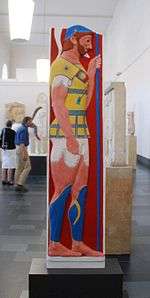Stele of Aristion
.jpg)
The Stele of Aristion dates from around 510 BCE. It was created by sculptor Aristokles out of pentelic marble and shows traces of polychrome.
Description
The Stele of Aristion or the Marathon Stele is a funerary stele in the National Archaeological Museum, Athens (NAMA, inventory number 29) which dates from around 510 B.C. The work is among the best sculptures from late Archaic Greece. It is made of Pentelic marble and measures 2.02 m high. The stele was found with its base, which is 0.24 m high. The uppermost portion of the head and helmet is missing. At the top of the base is an inscription, giving the name of the deceased in the genitive:[1] Ἀριστίονος "Aristion's". Aristion is depicted as a bearded hoplite soldier in profile, facing right.[2] He wears a short, thin chiton under a corselet. This was originally decorated with painted designs: meanders, zig-zags, and a star on his shoulder. The rest of the statue was also extensively decorated with paint - traces of red, yellow, and blue paint still survive. Aristion also wears an Attic helmet and greaves. His right arm hangs at his side, his left hand holds a spear. Some details are especially well-worked, like the wavy beard, the hair, and the musculature of the arms, legs and chest. In the empty space under his feet there is a horizontal inscribed band, which names the sculptor of the stele: ἔργον Ἀριστοκλέος "Work of Aristokles".

Creation
Sculptor Aristokles was known to have his signature on several bases, but his only famous work is Stele of Aristion.[3] This commemorative funerary stele dates from the last quarter of the century, Aristokles adds his signature on each of his sculptures. His name then appears on an Attica inscription found at Hieraka, Cape, Greece.[4] Aristokles subject is craved in low relief in profile. This 6th century Greek sculptor is very mysterious due to the lack of information about him.
Polychrome
Although the Stele is currently white, this would not have been the case of the Archaic period of Attica. It was not an uncommon practice to add polychrome as a decorative element of marble stele. The Stele of Aristion was originally decorated with painted designs: meanders, zig-zags, along with a star on his shoulder.[4] There are also remnants of red pigment located on the ground of the relief, on the end of the shoulder strap, and on the drapery. The amour of the soldier would have been a blue tint, and the hair would be that of a dark color.
Purpose of funerary stelae
Funerary stelae were placed on slabs of stone that would be used as boundary markers by the ancient governments of Greek and Rome.[5] This was to mark where the property lines existed. The surface of the stele is mostly decorated with a text, ornamentation, or sometimes both.[4] The text written on the stele would be that of the name of the deceased along with the signature of the artist.[5] The main purpose of funerary stelae was to commemorate loved ones. During this time the Greek society made it important to show their family with respect and love by commissioning a grand funerary stele in their honor. People that were fortunate enough to afford funerary stelae were that of the elite society. This was another way to display one's wealth through funerary stelae and other funerary monuments. In 480-430 B.C., legal restrictions we placed on flamboyant displays.[4] The deceased depicted on the funerary stele of Aristion is depicted as a hoplite soldier in profile. Men were usually depicted according to their roles in society. Many of these roles shown through funerary stelae would usually be young, athletic, heroic, or bearded with a staff. It is a common theme for the deceased to be represented in a familiar surrounding, as a way to preserve the memory of the deceased. The way people are portrayed on funerary stelae is very much in an idealized way. The importance of respecting and honoring the dead is a clear aspect in Greek life. Funerary stelae are similar to and influenced by the style from ancient Egyptians.[5] This connection between Egyptian culture and Greek culture is that they both value the importance of honoring a deceased loved one’s life. The similarities of the Egyptian style can be seen in the Stele of Aristion, shown by the low relief and the figure of the man in profile. Although, there are some similarities between these two ancient societies, they do not influence each other. In Ancient Egypt the funerary stele was only that of pharaohs and officials of the pharaoh.[5] While the Greeks put an importance on idealizing well-to-do citizens and people of authority.
Footnotes
- ↑ Inscriptiones Graecae (IG) I³ 1256; Image of the inscription.
- ↑ "Grave Stele of Aristion | Museum of Classical Archaeology Databases". museum.classics.cam.ac.uk. Retrieved 2017-12-15.
- ↑ "Digital Library". Digital Library. Retrieved 2017-12-15.
- 1 2 3 4 Murray, Alexander Stuart (1880). A History of Greek Sculpture: From the earliest times down to the age of Pheidias. J. Murray.
- 1 2 3 4 "Stele". Wikipedia. 2017-10-30.
Bibliography
Nikolaos Kaltsas: Sculpture in the National Archaeological Museum, Athens. The J. Paul Getty Museum, Los Angeles 2002, ISBN 0-89236-686-9, p. 70.